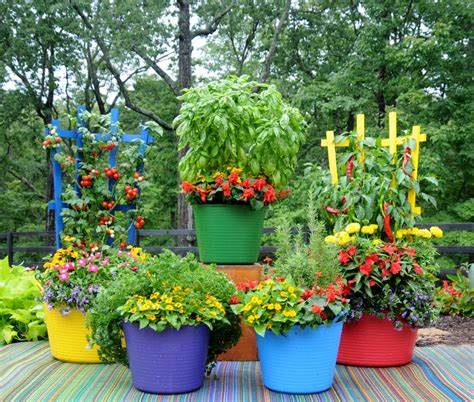Container Gardening
If you live in an area that isn’t suitable for growing things in the ground, container gardening might be for you! Container gardening is the growth of plants in a container as opposed to planting them in the ground. This process is sometimes called pot gardening.
There are a few types of things to consider when choosing a container to garden in. These containers are usually portable, small, and enclosed. Containers may take the form of a pot, box, tub, basket, tin, barrel, or hanging basket.

The type of the vessel depends on what is being planted in it, however, you should choose a vessel that allows ample room for root and soil spread. The Essex County Co-Op has several options that would be suitable for container gardening. A few of these are:
- Gro Pro Grow Bag
- Behrens Steel Pail
- Behrens Square Steel Tub
- Tuff Stuff Green Flex Tub
- Panacea Products Raised Garden Bed - 32 in X 46 in
- Panacea Wood Raised Garden Bed - 12 in x 24 in
- Round Fire Ring - 3 ft
When planting in containers, ensure that you use quality soil. The soil to use in your container should be well balanced and able to retain moisture and promote adequate drainage. Average garden soil may not drain well in containers and clay soil may be too dense and retain too much water for root health. To create the soil best suited for your plant, you can mix organic matter with sand. Soil for containerized plants should be:
-It should be a medium soil, therefore not too light or too fluffy
-It should have good drainage and be able to hold moisture
-It ought to be porous to allow for water and air to reach the plant’s roots
-The smell should be pleasant, moist, and not soggy
The Co-Op sells a variety of soils for container gardening, including:
- Dr. Earth Pot of Gold Organic All Purpose Potting Soil
- Coast of Maine Bar Harbor Blend Organic Potting Soil
- Dr. Earth Organic and Natural Exotic Blend® Cactus & Succulent Potting Mix
- Happy Frog Potting Soil
- Fox Farm Ocean Forest® Potting Soil
- Coast of Maine Castine Blend Organic Raised Bed Mix
- Miracle-Gro Potting Mix with Fertilizer - 1 cu ft
- Miracle-Gro Potting Mix with Fertilizer - 2 cu ft
- Coast of Maine Stonington Blend Grower’s Mix
 For best success, choose a plant that is well-suited to container gardening. These are predominantly flowers, herbs, and vegetables. The Co-Op sells hundreds of types of Hart’s and Botanical Interests seeds for you to choose from.
For best success, choose a plant that is well-suited to container gardening. These are predominantly flowers, herbs, and vegetables. The Co-Op sells hundreds of types of Hart’s and Botanical Interests seeds for you to choose from.
After you choose a container and plant in it, it is important that you establish good drainage. Drainage holes are essential. Without them, the plant will become waterlogged and might die. Drilling holes in a container of your choosing is an option, or if you prefer to avoid drilling holes yourself, select a container with pre-established drainage holes. When drilling holes, make sure they are about the size of a pea to ensure soil doesn’t run out of the holes.
When placing your containers around your property, try to avoid just putting a plant in a container somewhere because it looks good. Plants have specific requirements, and following those requirements gives your plant a better chance to thrive.
Sunlight is a major requirement for plants. Some plants prefer indirect light (having light reach them but not shine directly on them) and some plants prefer direct light (the sun beaming down on them). Yet others prefer shady spots. Ensuring that you research the needs of the plants you plant will be beneficial in determining their placement. One benefit to container gardening is that the containers can be moved to a new spot if you see the plant is struggling. For example, if a plant’s stem and leaves are growing in a way that is leaning them towards the light, the plant is not receiving enough sunlight. You should move that container to a more suitable location.
The temperatures that different plants like also vary. Some may require warm temperatures while others prefer cooler temperatures. It is imperative that you protect your plants from frost, especially if they are fruit-bearing plants. If frost is expected and your non-frost hardy plants are still outside, securely cover them with a tarp or something similar to protect them.
It is also important that you establish how much water your plants require. You should place containers in a spot that is easy to water since you’ll likely need to water your plantings. The frequency of watering the plants depends on the plant size, time of the year, and the type of plant.
Still not convinced container gardening is for you? Container gardening requires less weeding than traditional gardening since weeds are less likely to wind up in your container. Additionally, planting in containers means the plants can be placed virtually anywhere, including balconies, patios, and courtyards. Planting in containers also allows for greater accessibility, meaning this method of planting is more accessible to those with limited mobility. Lastly, container plants can be rearranged an infinite number of times, so if you’re indecisive on where to plant, this gardening method is for you!
